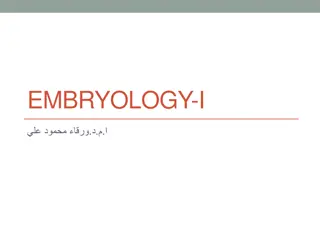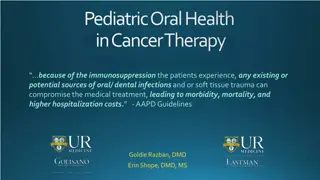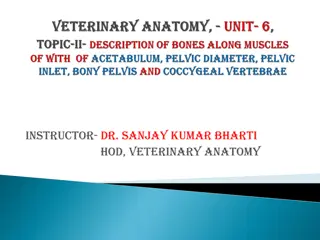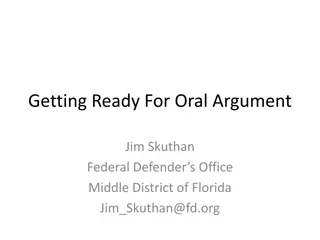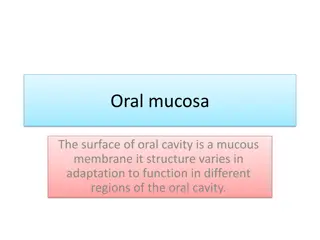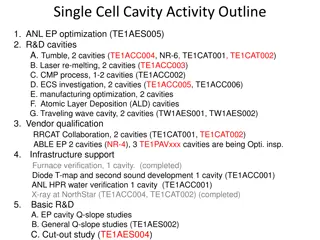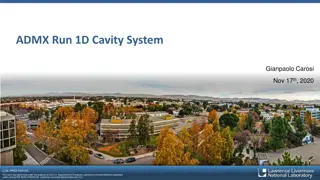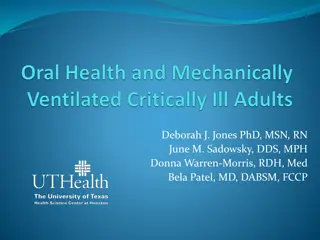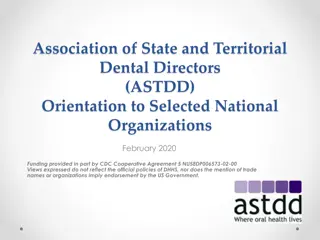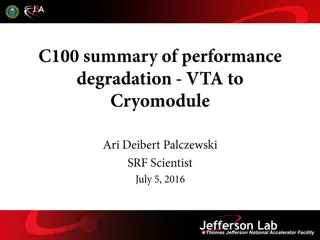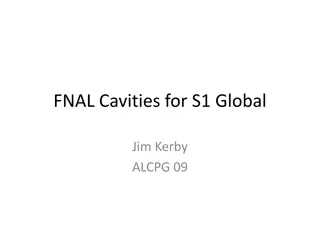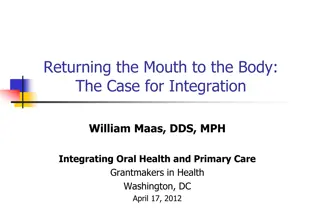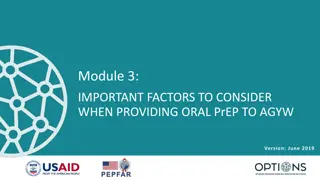Understanding the Anatomy of the Oral Cavity
The oral cavity extends from the lips to the hard and soft palate and houses various structures like the tongue, buccal mucosa, floor of the mouth, hard palate, gingiva, and lips. This detailed overview covers the different regions of the tongue, mucosal linings, salivary glands, and palatal structures, providing valuable insights into oral anatomy.
Download Presentation

Please find below an Image/Link to download the presentation.
The content on the website is provided AS IS for your information and personal use only. It may not be sold, licensed, or shared on other websites without obtaining consent from the author. Download presentation by click this link. If you encounter any issues during the download, it is possible that the publisher has removed the file from their server.
E N D
Presentation Transcript
Oral cavity extends anteriorlyfrom vermilion junction of lips to junction of hard and soft palate above and to line of circumvallate papillae on dorsal tongue below; communicates freely with oropharynx posteriorly Oral cavity contains buccalmucosa, maxillary and mandibulararches, retromolartrigone, anterior 2/3 of tongue, floor of mouth and hard palate
Dorsal tongue:villous, normally exposed surface; contains papillae and specialized taste receptors Ventral tongue:nonvillous, undersurface Anterior 2/3 of tongue (oral tongue):freely mobile portion of tongue that extends anteriorlyfrom line of circumvallate papillae to undersurface of tongue at junction of floor of mouth; composed of skeletal muscle, includes 4 areas: tip, lateral borders, dorsum and undersurface (nonvillous ventral surface of tongue) Base of tongue (posterior 1/3 of tongue):bound anteriorlyby circumvallate papillae, laterally by glossotonsillarsulci and posteriorly by epiglottis
Buccal mucosa:all of membrane lining inner surface of cheeks and lips from line of contact of opposing lips to line of attachment of mucosa of alveolar ridge (upper and lower) and pterygomandibular raphe; contains ostiaof main duct of parotid gland (Stenson duct). Floor of mouth:semilunar space of myelohyoid and hyoglossusmuscles, extending from inner surface of lower alveolar ridge to undersurface of tongue; posterior boundary is base of anterior pillar of tonsil; divided into two sides by frenulum of tongue, contains ostiaof submaxillary and sublingual salivary glands
Hard palate:forms roof of oral cavity; semilunarsurface between upper alveolar ridge and mucous membrane covering palatine process of maxillary palatine bones; extends from inner surface of superior alveolar ridge to posterior edge of palatine bone . Gingiva: mucosa in area of teeth and palate; extends from labial sulcus and buccalsulcus to a cuff of tissue around each tooth.
Lip: begins at junction of vermilion border (mucocutaneousjunction) with skin, includes only vermilion surface or that portion of lip that comes into contact with opposing lip; upper and lower lip are joined at commissures of mouth; external surface is skin and mucous membrane; internally contains orbicularis orismuscle, blood vessels, nerves, areolar tissue, fat and small labial glands; inner surface of lip is connected to gum in midline by frenulum, a mucous membrane fold.
Lower alveolar ridge:mucosa overlying alveolar process of mandible which extends from line of attachment of mucosa in lower gingivobuccal sulcusto line of free mucosa of floor of mouth; posteriorlyextends to ascending ramus of mandible. Retromolar gingiva (retromolar trigone): mucosa overlying ascending ramus of mandible from level of posterior surface of last molar tooth to apex superiorly, adjacent to tuberosity of maxilla.
Tonsillar area: anterior and posterior tonsillar pillars and tonsillarfossa Upper alveolar ridge:mucosa overlying alveolar process of maxilla which extends from line of attachment of mucosa in upper gingivobuccalsulcus to junction of hard palate; posterior margin is upper end of pterygopalatinearch Vermillion border:mucocutaneous junction of lip
Epithelium: Stratified squamous epithelium often with parakeratosis No hair follicles or sweat glands present Keratinization in areas most exposed to mastication (gingiva, hard palate, dorsum of tongue) Lamina propria contains loose connective tissue, mucous glands, serous minor salivary type glands
Submucosahas dense collagenous fibrous tissue. Oral tongue mucosa: modified keratinized squamous epithelium with small papillae; papillae can be filiform (majority, conical projections of keratinized epithelium), fungiform(rounded elevations, nonkeratinized), foliate (along sides of tongue) or cirucumvallate (at junction of anterior 2/3 and posterior 1/3 tongue, largest papillae). Taste buds: barrel shaped, lightly staining, intramucosal sensory receptors present in large numbers on circumvallate papillae and in lesser numbers elsewhere . Intraepithelial nonkeratinocytes: melanocytes (basal), Merkel cells (basal), Langerhans cells (suprabasal) and lymphocytes occur in oral mucosa.
Ectopic sebaceous glands (Fordyce spots) increase with age in adults Tonsillectomy specimens frequently contain skeletal muscle. Oral epithelium expresses cytokeratin 5and 14, ABO blood group antigens Taste buds express low molecular weight keratins, such as CK18and CAM5.2
Ectoderm/ ameloblsts/ enamel matrix Mesoderm/ odentoblast/ dental matrix Dentin / enamel / cementum Dental pulp
Dental caries Periodontal Pathology Cysts Odentogenictumor Bone diseases Infectious diseases Developmental abnormality
Indications: Alteration from normal: When it is not possible to identify the condition clinically, a histopathological investigation is necessary. Evaluation of histological nature: to evaluate the exact histological nature of any soft tissue or intra- osseous lesion. Screening of abnormal tissue: Confirmation of diagnosis: Evaluation of nonneoplastic lesion: such as mucosal nodules,papilloma,erosive lichen planus, erythemamultiforme, lupus erythematous pemphigus, pemphigoid and desquamativegingivitis.
Contraindication : Inflammatory lesion: Biopsy is not usually indicated in acute infalmmatorylesion. Site near the vital structure: One should be very careful while performing biopsy of the lesion adjacent to vital structure. Angiomatous lesion: Unless it is needed you shouldn t go for the biopsy of angiomatous lesion.
Biopsy should not be delayed when following features are present: Rapid increase in size of the lesion that cannot be explained by inflammation, edema and opening of new vascular channels. Absence of any recognized irritant, particularly when the lesion is chronically ulcerated or bleeds spontaneously. Presence of firm regional lymph nodes, especially when they seem to be fixed to surrounding tissues. Destruction of roots and loosening of teeth with evidence of rapid expansion of the jaw History of malignancy elsewhere in the body, previous history of oral cancer and radiation therapy.
Application of Biopsy in Dentistry Diagnosis of pathologic lesions Determining neoplasticand non-neoplastic lesions Therapeutic assessment Grading of tumor Diagnosis of metastatic lesions Evaluation of recurrence
Complication of Biopsy Hemorrhage Infection Poor biopsy woundhealing Spread to adjacent organs and reaction to local anesthesia.
Ideal Requirement of Biopsy Tissue Less traumatized: o The tissue taken for biopsy should have minimal trauma. o Adequate representative tissue: It must include the most suitable representative pathologic region of a lesion for a pathologist to interpret. o To facilitate treatment: Biopsy sample should help to facilitate to prescribed treatment and assess its efficacy.
Teeth specimen: For the histologicexamination of teeth, the apex of tooth should be clipped with a pair of pliers or a small hole should be drilled into the radicularpulp with dental bur to allow penetration of the fixative. The excellent preservation of cellular detail required is obtained by following methods: Cutting the specimen into tiny blocks before fixation. Use of special fixatives that preserve cellular detail with minimum disruption from rapid dehydration or osmotic shock. Post fixation and processing of tissues in the laboratory after the initial period of prefixation. As soon as possible after the surgical procedure.
Incisional Biopsy: can be performed by removing a wedge shaped specimen of the pathological tissue along with surrounding normal zone.
Indications: Large lesion: If the lesion is large and diffuse and extends deeply into the surrounding tissue so that total removal cannot be obtained easily with local anesthesia, an incisionalbiopsy is indicated. Management point of view: Lesions in which diagnosis will determine whether the treatment should be conservative or radical.
Excisional Biopsy: Total excision of a small lesion for microscopic examination is called as excisional biopsy . It is a therapeutic as well as a diagnostic procedure. Normal tissue on the margins of the lesion should be included. It is indicated when the lesion is relatively small and less than 1 cm in diameter, sessile or pedunculatedand well circumscribed; Tissues which are freely movable and located above the mucosa or just beneath the surface.
It is the preferred treatment if, the size of lesion is such that it may be removed along with the margins of normal tissue and wound can be closed primarily. Contraindication Larger lesions than 2 to 4 cm more cases are to be operated with proper surgical planning and anesthesia Vascular lesions e.g. hemangiomaTumors adherent to important vital structures or major blood vessels.
Exfoliative cytology: is a technique in which exfoliated cells assessed for pathological change. The cells examined are either manually scraped (mechanical exfoliation) or they are the cells which are spontaneously exfoliated.
Exfoliativecytology is an attractive option for early diagnosis of oral cancer including atypias and squamouscell carcinomas. It is a useful tool for detection, monitoring of initial alterations and establishment of adequate treatment. Recent advances in exfoliativecytology such as development of cytomorphometric method, DNA content determination, detection of tumor markers has contributed to renewed interest in this field. In this, the surface of the lesion is either wiped with some sponge material or scraped to make a smear.
Oral mucosal brush biopsy: This technique utilizes a disposable brush to collect a transepithelial sampling of cells. This brush has got 2 cutting surfaces i.e. flat end and circular border. Specimen obtained brushing on the site and smeared on clean labelled glass slide. The sample is screened by an neurally networked computer that is programmed to detect cytologicchanges associated with premalignancyand squamous cell ca.


